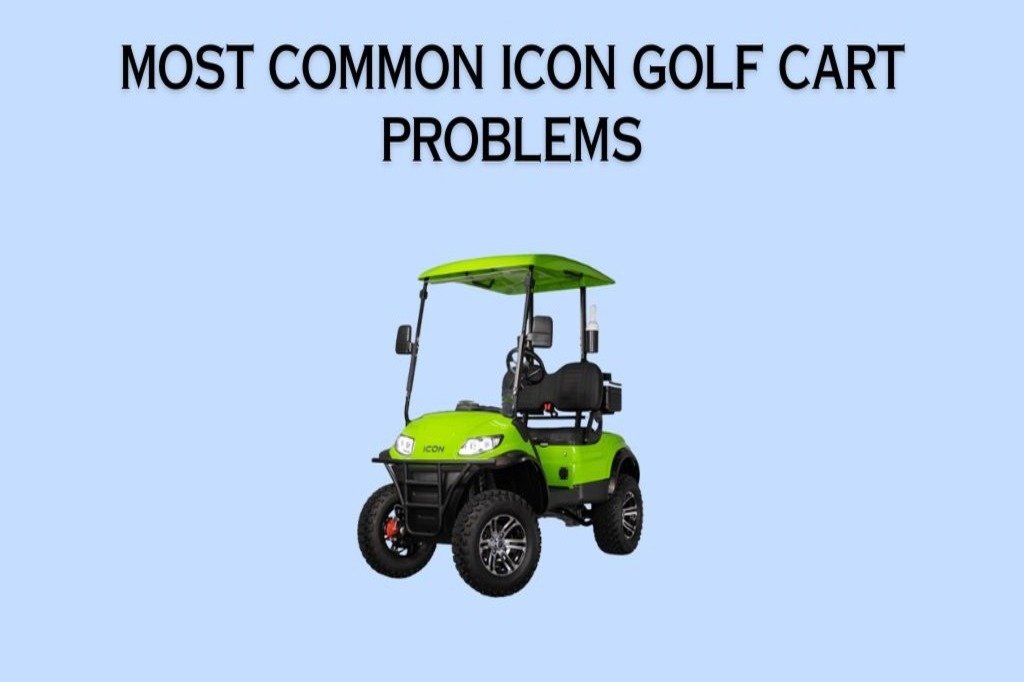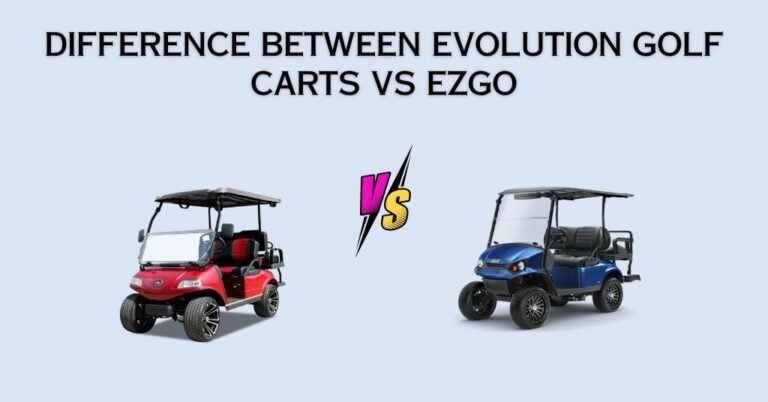Icon Golf Cart Problems – [exploring the reason & Fixes!]
If you own an Icon golf cart, you know how enjoyable it can be to cruise around the golf course or neighborhood. However, like any vehicle, golf carts can experience problems.
Icon golf carts can experience various problems related to batteries, motors and powertrains, steering and suspension, and the electrical system.
This article will discuss about the common Icon Golf Cart Problems issues that can arise with Icon golf carts and provide solutions to keep your cart running smoothly.

6 most common Icon Golf Cart troubleshooting
Here is a quick view table for you to understand the most common problems of Icon golf cart and their fixes:
| S.L | Problems | Fixes to apply |
|---|---|---|
| 1. | Problems with the battery | – Ensure proper charging techniques – Consider replacing old batteries. |
| 2. | Motor and powertrain issues | – Check for loose connections – Inspect and replace worn – out parts |
| 3. | Steering and suspension problems | – Inspect and replace damaged components – Tighten loose parts – Ensure proper alignment. |
| 4. | Electrical system failures | – Check and repair any faulty wiring – Replace blown fuses – Inspect for damaged electrical components. |
| 5. | Slouching or overinflated tires | – Pressurize the tires – Fix the tire Leaks – Change the tire |
| 6. | Brake Issues | – Replace the cable – Tighten the loose bolts |
Here are the clear causes behind the problems of your Icon golf cart and fixes:
1. Motor and Powertrain Problems
a) Lack of Power, Cart Not Moving, or Strange Noises:
Loose connections in the motor and powertrain can lead to electrical faults, affecting the cart’s performance and causing unusual noises.
How To Fix?
- To troubleshoot motor and powertrain issues, start by inspecting and securing all electrical connections.
- Tighten any loose connections for proper electrical flow.
- If the problem persists, seek assistance from a professional technician.
b) Worn-out Motor Brushes, Bearings, and Gears:
Over time, the motor brushes, bearings, and gears can wear out due to regular use, and lack of maintenance can cause this type of problem.
How To Fix?
- Periodically inspect and replace worn-out motor brushes, bearings, and gears.
- Regular maintenance can significantly extend the life of these components.
c) Lack of Lubrication:
Inadequate lubrication of moving parts in the powertrain can cause increased friction, leading to reduced performance and potential damage.
How To Fix?
- Regularly lubricate the motor bearings, gears, and other moving parts according to the manufacturer’s guidelines.
d) Overloading or Excessive Use:
Operating the golf cart beyond its intended capacity or constant heavy usage can put excessive strain on the motor and powertrain.
How To Fix?
- Adhere to the manufacturer’s guidelines regarding weight limits and usage recommendations.
- Avoid overloading the cart, and when using it for extended periods, allow sufficient time for cooling breaks to prevent overheating and mechanical stress.
2. Steering and Suspension Troubles
a) Worn-out or Damaged Steering Components:
Continuous use and lack of maintenance can lead to wear and tear in the steering components, such as tie rods, steering arms, and ball joints.
How To Fix?
- Inspect the steering system and identify any worn-out or damaged parts.
- Replace these components with new ones from the manufacturer or a reputable supplier to restore proper steering functionality.
b) Loose or Broken Suspension Parts:
The golf cart’s suspension system may develop issues over time, including loose or broken components like shocks, springs, or control arms.
How To Fix?
- Inspect the suspension system for any signs of damage or looseness.
- Tighten loose connections and replace broken suspension parts with suitable replacements.
c) Misalignment:
Improper wheel alignment can cause steering and handling problems, making the golf cart difficult to steer straight or maneuver accurately.
How To Fix?
- Check the wheel alignment using appropriate tools or consult a professional for accurate measurements.
- Adjust the alignment as needed to align the wheels correctly and improve the cart’s maneuverability.
3. Electrical System Failures
a) Faulty Wiring or Lose Connections:
Over time, wiring can become damaged or develop loose connections due to vibrations and wear.
How To Fix?
- Inspect all the wiring for any visible signs of damage or loose connections.
- Securely tighten any loose connections and replace damaged wires to ensure proper electrical flow.
b) Blown Fuses:
Excessive electrical load, short circuits, or faulty components can cause fuses to blow, interrupting the circuit.
How To Fix?
- Identify the blown fuse and replace it with one of the correct ratings as specified by the golf cart manufacturer.
- Additionally, investigate the root cause of the blown fuse to prevent it from happening again.
c) Damaged Electrical Components:
Some electrical components, such as switches, relays, or solenoids, can wear out or become damaged over time.
How To Fix?
- Inspect all electrical components for signs of wear or damage.
- Replace any faulty or worn-out components with new ones to restore their functionality.
4. Slouching or overinflated tires
a) Inadequate Pressure on Tires:
After using the golf cart for an extended period, the tire pressure may decrease, causing the tire to become slouchy. Similarly, overinflated tires can be problematic and lead to tire damage.
How To Fix?
- If the tire pressure is too low, use an air compressor to add the appropriate amount of air to reach the recommended level.
- It is good to follow the standard air pressure level. It’s between 15 to 25 pounds per square inch.
b) Tire Leaks:
Leaks in the tires can cause a gradual decrease in air pressure, resulting in slouching tires and rendering the golf cart unusable.
How To Fix?
- Visually inspect the tires for any visible punctures.
- If the leak is not immediately visible, you can use a soapy water solution.
- For small punctures or leaks, you can use a tire repair kit to patch the damaged area.
c) Expired Tire:
Like any other tire, golf cart tires also have an expiration time. If the tire’s lifespan expires, it may become overinflated or unusable.
How To Fix?
- If your tires are expired, and you need to replace them with a new tire.
5. Brake Issues
a) Loose Bolts:
Loose bolts on the lift kits can lead to brake-related problems, causing the cart to not function properly.
How To Fix?
- Regularly inspect and tighten all nuts and bolts on the lift kits.
- Ensure they are securely fastened to prevent any brake-related issues.
b) Stuck Cables:
Stuck cables can result in faulty brakes, making it difficult to control the golf cart’s speed and stopping power.
How To Fix?
- Check the brake cables for any signs of sticking or binding.
- Lubricate the cables and all moving parts to ensure smooth operation.
- If the cables are damaged or beyond repair, consider replacing them with new ones.
c) Tangling Wires:
Tangled or damaged wires can cause issues with the golf cart’s brake system, leading to unreliable braking performance.
How To Fix?
- Inspect all the wires related to the brake system and ensure they are properly routed and not tangled.
- Replace any damaged wires or connectors.
- It’s essential to keep the wiring harness organized and in good condition to maintain proper brake functionality.
Icon Golf Cart Problems related – (FAQs)
1. How long does an Icon golf cart battery last?
Icon golf carts can go 25 to 50 miles on a single charge with a fully charged 48-Volt AGM battery.
2. How do I know if my golf cart battery is bad?
Longer charging times for golf cart batteries can be a clear indication of battery decline. If your golf cart previously charged fully overnight but now requires 12 hours or more, it’s likely due to failing batteries.
3. How do you reset the Icon golf cart charger?
To reset the Icon golf cart charger, Turn off the key and plug in the cord until the indicator turns green < Turn the key on briefly, turn it off again < Finally unplug the cart.



![Evolution D5 Golf Carts Reviews – Worth Or Just A Hype In [2024!]](https://www.craborchardgolfclub.com/wp-content/uploads/2024/04/Evolution-D5-Golf-Carts-768x479.jpg)
![Troubleshooting Guide For Star EV Golf Cart Problems [2024!]](https://www.craborchardgolfclub.com/wp-content/uploads/2024/01/Star-EV-Golf-Cart-Problems-768x480.jpg)
![Evolution Golf Cart Problems [6 Issues Troubleshooting]](https://www.craborchardgolfclub.com/wp-content/uploads/2023/10/Evolution-Golf-Cart-Problems-768x402.jpg)